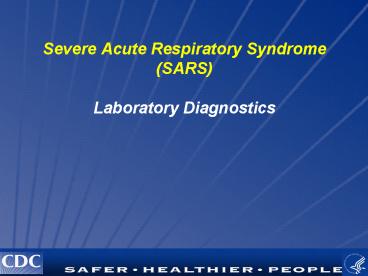Severe Acute Respiratory Syndrome SARS Laboratory Diagnostics - PowerPoint PPT Presentation
1 / 28
Title:
Severe Acute Respiratory Syndrome SARS Laboratory Diagnostics
Description:
sputum aspirates NP/OP washes NP/OP swabs. more sample. multiple samples. Others specimens ... (sputum, nasal aspirate/wash, np/op swabs) Blood ... – PowerPoint PPT presentation
Number of Views:111
Avg rating:3.0/5.0
Title: Severe Acute Respiratory Syndrome SARS Laboratory Diagnostics
1
Severe Acute Respiratory Syndrome
(SARS)Laboratory Diagnostics
2
SARS DiagnosticsShould we be testing for SARS?
In the absence of documented SARS
transmission, diagnostic testing for SARS-CoV
should NOT be considered unless there is a high
index of suspicion for SARS (e.g., a strongly
suggestive clinical presentation and a travel
history to a previously affected SARS area) and
no alternative respiratory diagnosis.
3
SARS Diagnostics Word on the Street
Labs are not fully comfortable with the PCR
assay for SARS because much about it is
unknown. APHL Public Health News State Public
Health Laboratories Put to the Test with SARS
4
SARS DiagnosticsPreparedness
- Performance of current diagnostic tests
- New diagnostic tools
- Optimal specimen types and timing
- Quality control
- Other respiratory pathogens rule-out testing
5
SARS DiagnosticsCell culture
- BSL-3 Activity
- Restricted culture range
- Vero E6 cells
- CPE
- focal
- cell rounding
- refractile appearance
P Rollin, Special Pathogens Branch
6
SARS Diagnostics Electron Microscopy
C Humphrey, Pathology Activity Program
7
Syncytial giant cell in lung of SARS patient
IHC staining of syncytial cells in
coronavirus-infected Vero cells (antigenic group
I antisera)
S Zaki, Pathology Activity Program
8
SARS Diagnostics Phylogenetic Analysis
PEDV
I
TGEV
CCoV
FIPV
HCoV-229E
100
III
IBV-Avian
68
TCoV
100
100
MHV
SARS
Rat-SDAV
II
HEV
HCoV-OC43
BCoV
10 nt
9
SARS Diagnostics Antibody tests Enzyme
immunoassay
Substrate
Anti-Human Conjugate
Human Serum IgG
SARS-CoV Antigen
Solid-phase
10
SARS Diagnostics Antibody tests
Immunofluorescence Assay
11
SARS Diagnostics RT-PCR First Generation Tests
12
SARS DiagnosticsReal-time RT-PCR
- Conventional vs Real-time RT-PCR (TaqMan)
- increased sensitivity (1-10 transcript copies)
- increased speed/throughput
- quantitative
- reduced risk of amplicon contamination
- Multiple genetic targets
- nucleocapsid and polymerase genes
- amplification of 2 of the 3 targets required
for - a positive test
13
SARS DiagnosticsReal-time RT-PCR
14
SARS DiagnosticsReal-time RT-PCR
- Conventional vs Real-time RT-PCR (TaqMan)
- increased sensitivity (1-10 transcript copies)
- increased speed/throughput
- quantitative
- reduced risk of amplicon contamination
- Multiple genetic targets
- nucleocapsid and polymerase genes
- amplification of 2 of the 3 targets required
for - a positive test
15
SARS Diagnostics RT-PCR Interpretation of Test
Results
- Potential for false negative results
- low titer virus in respiratory secretions in
first - few days after onset of illness
- Potential for false positive results
- contamination from previously amplified DNA
- cross-contamination between specimens
- All test results must be interpreted in the
context of the clinical and
epidemiological findings
16
SARS Diagnostics RT-PCR Interpretation of Test
Results
- Confirmation of a positive SARS RT-PCR test
- repeat the RT-PCR using the original sample
- have the sample tested in a second laboratory
- Positive SARS diagnostic test finding
- at least 2 different clinical specimens
- the same specimen collected on 2 or more days
WHO recommendations http//who.int/csr/sars/labme
thods/en/
17
SARS DiagnosticsSerology Current EIA
- Serology appears to be highly specific
- no reactions with other documented CoV
infections - (OC43 and 229E)
- no reactions with normal blood donors (U.S.
and - Hong Kong populations)
- Serology can be positive in as few as 8 to 10
days after - onset of symptoms
- Serology cannot be considered negative until gt28
days - after onset of symptoms
18
SARS DiagnosticsSerology - New assays
- Native virus vs recombinant antigens
- nucleocapsid, spike, and membrane proteins
- safety, standardization, and sensitivity
- IgM assays
- IgM antibodies may be detectable earlier in
the course of infection - Transient response
- Neutralization and other immunological markers
19
SARS DiagnosticsSpecimen Selection and Timing
- Respiratory tract specimens
- LRT gt URT
- sputum gt aspirates gt NP/OP washes gt NP/OP swabs
- more sample
- multiple samples
- Others specimens
- blood plasma
- stool
- Timing of specimen collection
20
Peiris et al Lancet, May 24, 2003
21
Peiris personal communication
22
SARS DiagnosticsSpecimen Selection and Timing
23
SARS DiagnosticsQuality Assessment
- QA CDC
- Standardized test controls
- Internal confirmatory testing
- External WHO quality assurance study
- QA LRN APHL
- Identical assays performed at CDC
- Confirmatory testing
- Proficiency testing
24
SARS DiagnosticsOther Respiratory Pathogens
Rule-out testing
- Why test for other respiratory pathogens?
- may help rule out concerns about SARS
- possibility of mixed infections
- When to test for other respiratory pathogens?
- What respiratory pathogens to test for?
- Which tests to use?
25
SARS DiagnosticsOther Respiratory Pathogens
Rule-out testing
Other respiratory pathogens, U.S. SARS
surveillance, March-July, 2003.
Schrag SJ et al. SARS surveillance in the United
States during the Emergency Public Heath
Response, March-July, 2003. EID (In press).
26
SARS DiagnosticsOther Respiratory Pathogens
Rule-out testing
- Provide guidance on test
- What other tests are available?
- What are their performance characteristics?
- Provide guidance on testing
- Clinical presentation
- Demographics (e.g., age)
- Seasonality (NREVSS)
- Provide RT-PCR protocols
27
SARS DiagnosticsKey Messages
- Serologic and RT-PCR assays are sensitive and
specific, but may not provide definitive
diagnosis early in illness - Changes in the type, timing and quantity of
specimens collected may improve detection - Interpretation of test results must take into
consideration possibility of false positives and
negatives - Confirmation of positive results by a qualified
second laboratory essential when SARS is
infrequent
28
SARS DiagnosticsPreparedness Web Resources
- Specimen packaging shipping
- http//www.cdc.gov/ncidod/sars/packingspecimens-s
ars.htm - Specimen handling processing
- http//www.cdc.gov/ncidod/sars/sarslabguide.htm
- Specimen testing RT-PCR
- http//www.cdc.gov/ncidod/sars/lab/rtpcr/index.ht
m - Specimen testing Serology
- http//www.cdc.gov/ncidod/sars/lab/eia/index.htm
- Emerging Infectious Diseases
- http//www.cdc.gov/ncidod/EID/sars_links.htm































